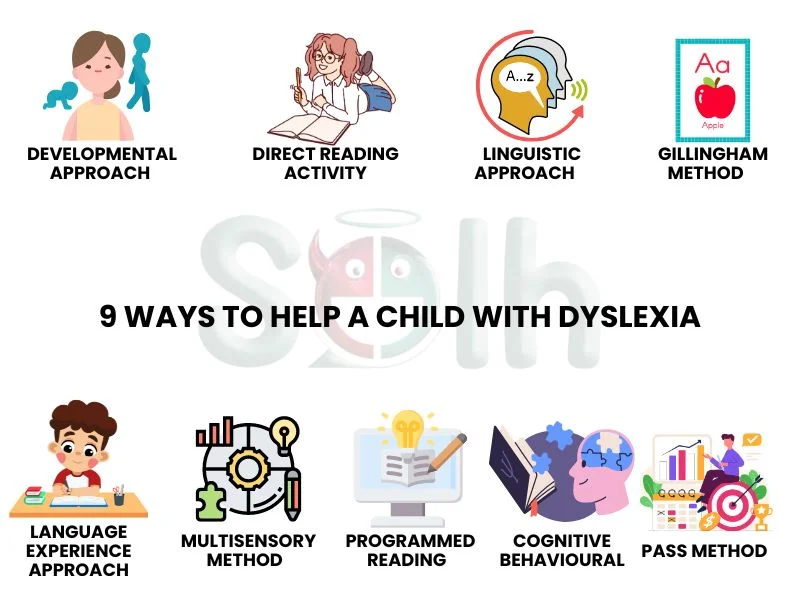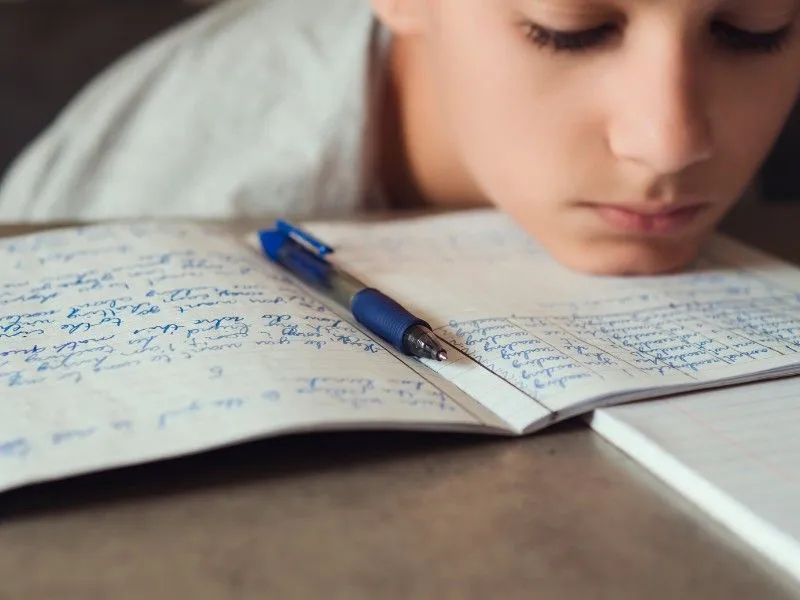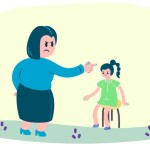Difficulties in reading begin even before a kid learns to read. Kindergarten-age children may not be able to recognize and write letters like their peers. The common symptoms people with Dyslexia have include difficulty memorizing, difficulty spelling, and difficulty understanding and thinking.
Common myths include thinking that children with Dyslexia write letters backward or those who write letters backward all have Dyslexia. Individuals with Dyslexia may try to avoid activities that require reading whenever they can (e.g., reading for pleasure or reading instructions). They may often gravitate to other mediums of expression, such as pictures, video, or audio.
Reading is one of the most demanding adaptive skills of the modern world; thus, reading difficulties cause tremendous problems in adaptation. The remedial methods used for improving reading can be put under two groups:
(1) code emphasis programme (CEP) and (2) meaning emphasis program (MEP). The former group of programmes is focused on letter-sound regularity, whereas the latter focuses on comprehension and is also called the whole language method (Jena, 2013).
For instance, in CEP, children are taught to learn phonemically similar words first in order to understand their structure in terms of phonemes through rhyming, such as Cat-Mat-Bat, whereas MEP uses decoding techniques to enhance comprehension by taking the most frequently occurring words in the child's language environment.
Dyslexia disorder is diagnosed when an individual has specific and significant impairment in the development of reading skills, which is not due to poor intellectual functioning, visual or auditory acuity, or poor schooling.
It includes reading skills like reading comprehension, word recognition, oral reading skills, and even impairments in skills that require reading. Most of them have a history of specific developmental delays in speech and language acquisition. At the early stage, difficulties are observed mostly in learning an alphabetic script, reciting the alphabet, naming letters, rhyming words, and analyzing or categorization sounds.
At a later stage, reading disorders may be manifested in omission, substitution, distortion or addition of words, slow reading rate, hesitations, reversals of words and even sentences, inability to comprehend or recall what was read, and so on. Difficulty in reading may be seen in other scholastic areas, such as arithmetic or writing.
Dyslexia is a specific learning disorder that refers to difficulty with reading. Individuals with Dyslexia have difficulty connecting letters they see on a page with the sounds they make. As a result, reading becomes a slow, effortful and not a fluent process for them.
Some Strategies to help a child with Dyslexia:

Developmental Approach
This approach takes the language development of the child into account. It introduces a sequential set of reading activities according to the emergence of vocabulary by engaging children in motivational activities. Such programmes are particularly useful for children who are multi-culturally disadvantaged groups. The approach is largely comprehension oriented.
Direct Reading Activity
In this approach, the student is motivated to prepare materials, new concepts, and encouraged to ask questions. Skills are developed through drill or workbook exercises. He/she learns new words through phonic methods.
Linguistic Approach
The linguistic approach is a whole-word approach, as words are taught in the context of word families or only as a whole. The emphasis is placed on the phone-morpheme relationship. Reading is taught in association with a child's natural language, from regular spelling to irregular spelling, so that an awareness of structures develops.
However, its major limitation is that there is little emphasis on comprehension, the vocabulary is extremely controlled, and distraction is caused by the use of nonsense words to teach their basic structures and pattern practice.
Gillingham Method
This is a highly structured and phonetically-oriented method (Gillinham, & Stillman, 1940) in which the teacher uses phonetic cards with names of alphabets written on them. Each letter sound is taught by using a multisensory method. The cards are exposed to the student, and the teacher reads the name of the letter.
This is then repeated by the student. After mastery of the name of the letter, the teacher makes the sound of this letter and asks the student to repeat the same. Then the teacher exposes the phonetic card and asks the student: "What does this card say?" expecting the student to produce the corresponding sound (phoneme).
In the next step, without exposing the card, the teacher utters the sound (phoneme) and asks the student to name the letter that represents the sound. Then, the teacher writes the letter, explaining its form. The student traces it, copies it, and writes it from memory.
Language Experience Approach
The language experience approach attempts to integrate reading with speaking, listening, and writing skills. Its focus is on the following three basic assumptions: (1) What the child thinks about and can talk about, (2) What the child can say and can write, and (3) What Specific Learning Disabilities or Developmental Disorders, a child can write, can read. Thinking, talking, listening, reading, and writing are precisely part of an integrated activity. Thus, the reading materials are selected according to the learner's interest.
Multisensory Method
This is also known as the Fernald method, as it was originally proposed by Fernald (1943). In this method, the child is first asked to write the word correctly, and then read it and thereafter move on to extensive reading material that is not his own. The stages to introduce these methods are as follows:
1 The teacher asks the student to find out the words that are difficult to learn, writes the word with a crayon, and asks the student to trace it out while speaking it aloud. He/she is asked to make stories using the word.
2 The child himself/herself writes the word, looking at the teacher's writing, and may begin reading from books.
3 Children recognize new words, learn about their similarities to the older ones, and expand their reading skills.
Programmed Reading
This is a self-teaching and self-correction approach. Instructional materials are prepared in such a manner that the learner gets a feedback by answering the questions provided at the end of the text and the answers in the next page or in the same page in reverse manner, so that he can turn it to read and self-check. In advanced computerized programmes, automatic evaluation reports, audio and video feedbacks are also made available for the learner.
Cognitive Behavioural
Method Like any other activities that require planning and execution of the strategy, reading also involves proper planning and implementation, which are close to thinking. Thus, reading is seen as an essential thinking activity. In view of this, children are taught how to prepare the strategy by analyzing their own thinking, such as (a) 'What do you think?' and (b) 'Why do you think' strategies', (c) 'Can you prove it?' strategies. Cloze tests are also used to assess their understanding of the text. In a close test, words are removed from the sentences at regular intervals, and the child is asked to fill in the blanks to read the text.
One who comprehends the text well is expected to perform better than one who has difficulty in comprehension. A six-step cognitive behavior therapy procedure was used effectively by Jena (2013) for the treatment of children with learning disability, which included (1) Task description, (2) Formulation of strategy, (3) Modeling, (4) Guided practice, (5) Verbalisation, and (6) Self-monitoring.
PASS Method
Das, Naglieri & Kirby (1994) proposed that the cognitive processes that are involved in intellectual performance, including reading, can be better understood through PASS (i.e., Planning, Attention, Simultaneous, Successive) Model, where Planning is explained as a mental process that provides cognitive control.
It involves strategies and plans, self-monitoring, self-regulation, and utilization of processes and knowledge to achieve a desired goal. Attention refers to the individual's focus on cognitive activities, including resistance to distraction and selective attention over time, whereas Simultaneous processing means a meaningful organization of many bits of information at the same time and arranging those data into interrelated groups.
Successive processing refers to the ordering of the information in a specific manner. In fact, the PASS model is an alternative theory of cognitive processing used extensively for teaching cognitive skills to children with learning disabilities and mental retardation.
School Collaboration:
Schools can also provide an important space to overcome Dyslexia. They can collaborate with parents, teachers, and counselors to streamline the support strategies used in classrooms and therapy sessions. They can empower kids with Dyslexia by providing them with emotional support and building coping skills that help them navigate the challenges.
How can parents help a child with Dyslexia
Parents play a crucial role in supporting their child with Dyslexia. Here are some ways you can create a positive and empowering environment at home:
Building a Strong Foundation:
- Early Intervention: If you suspect your child has Dyslexia, advocate for early evaluation and intervention. This can make a significant difference in their learning journey.
- Open Communication: Maintain open communication with your child. Talk about Dyslexia in a positive way and emphasize that it doesn't define them.
Focus on Strengths
Help your child identify and develop their strengths and talents in other areas. This could be music, sports, art, or anything they excel at. This will boost their self-esteem and confidence.
Creating a Supportive Learning Environment:
Positive Reinforcement- It can serve as the powerful tool to motivate and build a child's confidence. For example- you can appreciate tiny reading efforts taken by your children.
Break Down Tasks- For children with Dyslexia, you can break down the large, overwhelming tasks into smaller, more manageable tasks.
Quiet Study Space- To avoid any distractions for children with Dyslexia, provide a distraction-free space for them to work.
Explore Assistive Technology- Technology can be a powerful tool to help kids with Dyslexia. Features like audiobooks or text-to-speech software can help them in learning better.
Dyslexia can be challenging for someone dealing with it. However, despite the challenges, the tools and strategies can help a child cope with it.
Solh understands. We offer a variety of features to help you with anger.
Journaling for Self-Reflection: Sometimes, dealing with child experincing deslexia might be overwhelming. Solh's journaling feature allows you to explore your thoughts and feelings in a safe space. By reflecting on your experiences and desires, you can gain clarity on how to manage anger in the classroom.
Anonymous Support Groups: You are not alone. Solh's anonymous support groups connect you with others who understand the struggle of managing anger in the classroom. Share your experiences, find comfort in solidarity, and discover new perspectives on overcoming the hurdle to indulge in self care.
Solh Buddy: Feeling lost or disconnected? Your Solh Buddy, a personalized virtual companion, is here to provide encouragement and support along the way. It can offer prompts, celebrate your victories, and remind you of your strengths as you navigate the journey towards self care.
Talk now: Sometimes dealing with child having deslexia can make you feel overwhelmed. Solh’s talk now feature gives you access to dedicated counselors to help you navigate such situations.
Solh believes in a unique approach introducing strategies of dealing with child having deslexia, We empower you to take charge of your well-being by offering a variety of tools. Explore Solh today and discover the power of self-reflection, connection, and support in overcoming any problem of the mind. You are not alone on this path.








